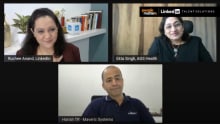It's key for HR to have an innate understanding of the business and know where it's headed, shares Manu Gopinath
One HR Read similar articles

The last year has been a period of rapid transition for companies. The pandemic began with few cases of COVID-19 being reported in some parts of the world, only to grow into a global pandemic shutting down various aspects of everyday life. For companies, the journey has been no less tumultuous. Yet the presence of digital tools for collaboration, communication, and learning, along with timely business decisions to shift to remote work, helped many organizations weather the storm. But one that signs of storms passing is slowly emerging, how have companies survived, and what lessons do we have for future periods of uncertainty? To explore some of the answers to these questions, LinkedIn Talent Solutions and People Matters indulged in a conversation with Manu Gopinath, COO at UST, for some insights and wisdom that came out of their experience dealing with pandemic as a global company
Q: How did UST deal with the disruption and uncertainty brought by COVID-19?
UST's experience dealing with disruptions in the past helped us respond to the pandemic with relentless speed and agility. We switched over 95% of our workforce into remote work mode within the first seven days of government instituted lockdowns. We established remote work policies and guidelines with speed to stay engaged and productive with the least amount of disruption. Employees were our primary focus. Prioritizing employee safety and well-being and security was vital. With COVID-19 related market uncertainty, we also wanted to ensure a quick and seamless transfer of all critical assets on digital platforms to help our employees remain productive. Marked by good pace, our shift to remote work and our digital capabilities tremendously helped us.
We learned a lot through this journey. To mitigate some of the adverse outcomes of remote work, such as isolation, disengagement, work-life balance, etc., supervisors and leaders have also stepped up to ensure increased 1-1 connect levels. Continuous learning is now a norm and reality. bite-sized, real-time e-learning has risen significantly. Moving ahead, we today have more clarity into how we manage our workforce's health and security while utilizing remote work strategically.
Q: What have been the significant shifts that the disruption brought for the better you noticed over the past year?
Culturally there has been a dramatic shift in how employees perform, work, and are engaged. If you remember, pre-COVID, most teams were collocated. Communication, collaboration, and trust were free-flowing and possibly taken for granted.
Unfortunately, in many organizations with remote work arrangements, all three are nearly elusive today, leading to a complete breakdown. Boards/HR leaders of many organizations were focused on reviewing the efficiency of communication and collaboration and even measuring the trust index of employees. We have also equipped our leaders and supervisors and constantly remind them to stay engaged with the teams on the ground. To mitigate some of the adverse outcomes of remote work, such as isolation, disengagement, work-life balance, etc., supervisors and leaders have also stepped up to ensure increased 1-1 connect levels–shifting from quarterly roundtables to weekly check-ins. We have established and socialized remote work policies, processes, and guidelines to ensure consistency and ease of operations. In addition to online learning, we have also launched several engagement programs, including an accelerated plan to identify, train and develop our talent to meet the rapid change in technologies. We have also set up global help desks for making the integration into remote work smoother.
The pandemic world has seen the high productivity levels that remote work can achieve. Studies have shown how small work remains a means to allow people to step in and step up to take on higher responsibility. That's what we've seen in UST as well.
Q: Given the business dynamics today, HR cannot work in silos but as one team to enable overall business success. Do you also agree with this thought?
No function under the HR umbrella can operate independently. Having a unified vision, superordinate goals, and collaboration between the various HR departments to achieve those goals is vital to successfully partnering with business stakeholders. HR organizations must be deliberate about knocking down silos and building cohesive teams. It indeed takes a village to deliver value and raise the HR brand. Departments such as workforce planning, talent acquisition, talent management, and learning should be looking at forecasting and getting the workforce ready for the future. They should also work with other organization departments and design and create ecosystems that promote a diverse and inclusive culture to engage and retain talent.
It is critical for HR today to have a deep understanding of the business and know where it's headed. Businesses are dynamic organizations where things can change on the fly. For HR, this translates to being well prepared for and understanding the nuances, incoming talent changes, and ready to support the potential growth opportunities for the business. Hiring the right talent for the right job will be essential. We at UST, for example, use LinkedIn Talent Solutions to look beyond geographical restrictions to hire the right talent. With the right people, companies can further innovate and make business processes more efficient.
The other area where HR professionals can cater to business success is enabling the transformation journey. I believe that transformation is more of a mindset shift than simply adopting the latest tools and technology. HR professionals need to spend time learning, coaching, and mentoring talent at all levels to engage and enable them during the transformation phase. A deeper understanding of the needs and wants of the talent and creating ecosystems where they can be successful will be critical elements for HR professionals.
Q: Given the rapid transition of work due to the pandemic, what has its effect been on learning platforms being used in UST?
Learning is one of the most powerful tools to ensure employee engagement.
UST has been laser-focused on upskilling its associates while they continue to work remotely. Virtual learning has been the primary or possibly even the only mode of delivering learning until we can safely get back to our workplaces. Our associates continue to leverage learning platforms like LinkedIn Learning, and curated learnings through our in-house learning academy - GAMA. We also have SME-led knowledge sharing sessions, online sessions for technical certifications, etc.
However, it is important for virtual learning to be combined with active coaching/mentoring and real-time application of the learning. Organizations are today learning for the future. The pandemic has driven organizations to use technologies – many of which need to be known by employees.
Q: What are some of the new skills and roles that you've seen emerge over the last year?
Business and technological shifts mean that the demand for new skills remains high. Today there is a lot more demand for more recent applications, more unique functionalities, and the need to leverage newer platforms. For instance, with most of the workforce working remotely, data security and related vulnerabilities have come to the fore. Cybersecurity, cloud migration from legacy systems have all become increasingly relevant in this day and age. Demand for skills like consulting on change management and enterprise agility has also gone up last year. A similar change has occurred in demand for hard skills where newer technologies dictate skill requirements. Such shifts are now reflected in a company's hiring policies.
Q: How has the changing nature of work due to the pandemic affected hiring in UST?
Considering that remote work has made it possible for us to meet our talent needs from a more extensive global pool, the talent pool has vastly increased to meet the steep increase in demand.
At UST, we have streamlined our hiring and onboarding process to make it entirely remote and virtual. Virtual campus tours give employees a feel of the office space and environment. We introduce them to the talent ecosystem well ahead of their joining to provide them with a head start. There is increased focus on hiring talent for their "base" skills where we use our in-house technology platforms and learning interventions to enable them to pick up new skills, view the upcoming demands, and apply for new roles that will suit their working style and aspirations. The talent scouting process for internal and external talent has brought us great results, with our internal fulfillment standing close to 60%. Referral programs have further strengthened the talent acquisition process.
Q: How would you encapsulate UST's efforts to provide the right employee experience during this time of crisis?
Organizations and their leaders need to accept the harsh realities and the impact of COVID-19 on their employees. While remote work has its positives, this arrangement is not conducive for all employees. That said, contrary to popular perception, employee engagement levels today are higher than pre-COVID days for most industries, except for a few. Each organization will have its unique challenges and hence may not adopt a "one size fits all" approach to engagement. It is crucial that the solutions we design evoke confidence, trust, enhance goodwill and engagement. That is what we focus on at UST.
As leaders, we need to keep our ears to the ground – always looking for those unseen rumblings. Being empathetic, compassionate, and transparent has significantly helped keep the trust quotient high.
Regular leadership updates, including those from the CEO and business heads, have kept our workforce well informed on growth, new opportunities, and any upcoming changes. And with all the social unrest we have had in recent times, leaders have a critical role in ensuring inclusivity, diversity, and equity. Leaders also must encourage managers/supervisors to be sensitive to the hardships faced by some employees and even redistribute work amongst team members where needed. Managers ensured weekly or bi-weekly check-ins to review progress and course-correct where necessary Regular employee connection, engagement, and performance must be the top agenda for managers.
Q: You've mentioned how employees have begun sharing experiences on LinkedIn. One study noted that this has also made companies aware of the burnout many are facing today. How is UST tackling this challenge?
The significance of employee well-being following the pandemic cannot be overstated. Well-being has assumed levels of a magnitude never seen in recent history. The well-being of associates is pivotal to the success of customer deliverables.
UST has been on top of its game to ensure associates are motivated, encouraged, and feel secure. We were quick to socialize our existing programs and launch new ones that would immediately help our associates. For instance, we established alternate work schedules to accommodate the changing needs of families, flexible benefits, free access to psychologists & counselors through our employee assistance programs. We also collaborated with the Heartfulness Foundation to provide access to live meditation sessions, positioned doctors at our wellness centers to reduce apprehension, access to telemedicine, webinars on awareness, precautions, personal hygiene, and social responsibility in the context of COVID-19. With social interactions almost completely shut off, we urged our managers to ensure regular virtual team events, both locally and with global teams. We also leverage News@Noon, our daily corporate newsletter, to promote positivity and emphasize the importance of collaboration and compassion. And staying with collaboration, we regularly organize virtual games and competitions within teams with exciting prizes. We have organized ongoing events for families of our associates, including coding lessons for children, wellness competitions, engaging toddlers and teenagers.
Q: For UST, what does the future of work look like: hybrid or remote?
For us, it will be hybrid. Our way of functioning depends significantly on our customers and how they like things to happen. Specific customers required us to be physically present in offices. Automated shift arrangements are managing those teams. Others have accepted remote work options. As vaccination rates go up and overall conditions improve, people might change their opinion of coming to office. What we can do now is remain open and flexible. It's good not to have a set path on this but rather monitor the changes and take decisions accordingly.






